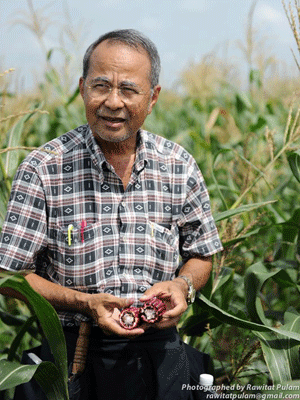CTAHR Prof. Brewbaker: Legacy of a crop geneticist
Meet ‘Dr. B’ and three of his successful students
by Martha Hanson
Visit Dr. Jim Brewbaker at UH Mānoa’s College of Tropical Agriculture and Human Resources (CTAHR) Waimānalo Research Station and he not only shows you the latest seed corn in development but can provide you the long lineage of how that corn came to be. This horticulturalist and crop geneticist keeps meticulous handwritten records of his plantings, harvests and outcomes in small journals. He has hundreds of them going back nearly seven decades. His journals document the development of important new varieties of crops that improve nutrition, resist pests and disease, and provide higher yields to feed more people.
“As a typical plant breeder, I’m always optimistic about the future but pragmatic about what has been achieved – for it’s never quite enough in a world of seven billion where two billion are hungry,” said Brewbaker. “The world only had two billion when I was born!” adds the octogenarian professor.
Through his father, Brewbaker can trace his crop geneticist lineage back to Gregor Mendel, the father of modern genetics. Brewbaker’s dad studied with Dr. H. K. Hayes, who in turn studied with E. M. East, who was among the first to embrace Mendel’s genetic principals rediscovered in the early 20th century. Brewbaker studied crop development at Cornell with Sandy Atwood and then with Nobel laureate George Beedle at Caltech. After working in Sweden and then the Philippines, Brewbaker moved his family to Hawai‘i in 1961 to join CTAHR at the invitation of then department chair Jim Gilbert.
Brewbaker has been instrumental in developing the seed corn industry in Hawai‘i, whose climate lends itself to year-round seed propagation and development. Today the seed corn industry is valued at one third of the entire agriculture industry of Hawai‘i and generates nearly $250 million annually and growing.
At CTAHR he created Hawai‘i Foundation Seeds, which manages collections of parent seed stocks – overseeing their collection, evaluation, purification and propagation and providing seed samples and education to the community. The largest collections are corn and tropical legume trees, such as Acacia (koa) and Leucaena. He has won awards and accolades for his work from every major plant breeding organization and is working on his 283rd publication.
After 51 years at UH Mānoa, Brewbaker is still very involved in plant breeding. He plants and harvests almost weekly while keeping copious notes. He says his most recent publication is “about a virus that ruined some of my sweet corn hybrids since one of their parents turned out to be susceptible. We’ve been hastily squashing this problem by converting the offending parent to resistance. Our efforts are going very well and dominating my summer corn fields.” Ever gregarious and generous, he adds, “Incidently [the fields] are bursting with edible items, should you be able to visit us one day!”
While Brewbaker’s plant crop development is impressive, his greatest legacy may be the crop of geneticists that he has mentored and to whom he’s known as “Dr. B.” In a 1999 article about his mentor, former student Ganesan Srinivasan, who was recently named dean of Agriculture and Natural Resources at California’s Santa Rosa Junior College, noted, “Dr. B modestly claims he would have achieved nothing without his graduate students. His students say otherwise. We could not have achieved anything without his inspiration and training.”
Through his Dr. B Newsletter, he keeps in touch with 52 of his majors and more than 60 post-docs, APTs, visiting professors and students who have minored with him. In it, he shares news about UH, CTAHR, the Tropical Plant & Soil Sciences and Hawai‘i’s seed industry and encourages his alumni and colleagues to stay in touch by sharing personal updates and email addresses.
Here are three of Brewbaker’s academic offspring, who illustrate how his legacy touches millions of people around the world through the seeds that he and his students develop and produce:
 |
|
| Dr. Taweesak Pulam
|
Taweesak Pulam (PhD ’78) is the son of a rice farmer on the Central Plain of Thailand. He graduated from Kasetsart University, the dominant agricultural school in Thailand, with a degree in soil science before coming to UH on an East-West Center scholarship to pursue a masters in soil physics. This changed to an MS in plant breeding before eventually becoming a doctoral student with Brewbaker. After graduation, he worked for Pioneer Hi-Bred International in the Philippines and later Thailand until a corporate conflict eliminated his job. At that point he could choose to go into trading or teaching. Instead he chose to live or die working on corn breeding. In 1991, he established a small company called Sweet Seeds Co., Ltd., to develop sweet corn hybrids for farmers in Thailand. Pulam successfully developed the sweet corn hybrid ATS-2 that really made the sweet corn industry in Thailand possible. At this time the Thai sweet corn industry exports about 5 billion baht ($170 million) each year. Pulam has received many awards for this, including being selected by the Prime Minister’s Office as a prestigious Outstanding Citizen for Economic Development, an award he received from the Crown Princess of Thailand. His work continues and he is in the process of developing the first red super sweet corn – a commercial hybrid called “Siam Ruby Queen.”
“I get all my knowledge in plant breeding from the University of Hawai‘i. The great experience was field work at Illinois Foundation Seeds where Dr. B likes to send his students for one summer,“ said Pulam. “I think what I get from Dr. B is his love for plant breeding. He always goes to the field before coming to campus. This is what I always do now if I have a chance.”
Pulam remembers walking into the cold room at the Waimānalo Agricultural Experiment Station and Dr. B saying, “Do you know that some seeds in this room are worth a million? The problem is that we do not know which one.” Years later, Pulam showed Brewbaker his new cold room in Thailand and said, “The difference here is that we do know which one is worth millions!”
 |
|
| Dr. Brewbaker and Dr. Sarah Nourse Styan
|
Sarah Nourse Styan (PhD ’00) grew up in Whately, a small town in western Massachusetts on her parents’ small fruits nursery, Nourse Farms. Inspired by their contributions to agriculture, she received her undergraduate education from Cornell and worked for a plant breeding research station in California before obtaining her master’s in crop science and plant breeding at Wageningen Agricultural University in the Netherlands. She chose UH for her doctorate because she was interested in an applied plant breeding program using molecular tools reflective of some of Brewbaker’s work.
At UH she found Brewbaker’s international experience of great interest and inspiration. She and another student spent six months working with him on his sabbatical at the renowned research center CIMMYT in Texcoco, Mexico, where they worked with many scientists from all over the world and were even able to meet Norman Borlaug, considered the father of the “green revolution.” She also worked for four months at the Kamphaeng Saen Campus of Kasetsart University in Thailand through another collaboration that Brewbaker had developed and where she was generously hosted by fellow alumnus Taweesak Pulam. Styan explains, “With my interest in plant breeding, agriculture and travel, those were wonderful experiences that go far beyond the education components associated with my PhD work and would not have been possible without Dr. B's help and support,” she said. “He goes far beyond just educating his students in his area of expertise, but also in the breadth and scope of the world and all it has to offer in agricultural research and culture.”
Since graduation, she completed a post-doc with the U.S. Department of Agriculture. She also contributed molecular markers to the strawberry research community through her work at the ARS Fruit Lab in Beltsville, Md. – a feat for which she’s proud for contributing to her parents’ many years of work. For the past 10 years, she has worked at the Waimea Research Center of Pioneer Hi-Bred on Kaua‘i, where she is a research scientist in the global marker technologies group and manages the molecular marker lab. At Pioneer she is generating data in the lab that is impacting the plant breeding process in the field – helping to supply better seeds to farmers all over the world.
 |
|
| Dr. Pek, Dr. Soon Kwon Kim and Dr. Brewbaker
|
Soon Kwon Kim (PhD ’74) is known as “Dr. Corn” in his native Korea. The son of a poor farmer, Kim was no stranger to hunger as a child. After attending Kyungpook National University and Korea University on scholarships, he arrived at UH Mānoa with an East-West Center scholarship and a dream to develop miracle corn to reduce hunger.
Working with Brewbaker, Kim experimented with disease-resistant corn and hybrid varieties at UH’s Waimānalo station and found ways to control two serious pathogens of corn that cause billions of dollars of crop losses worldwide. After returning to Korea in 1974, he overcame skepticism about his new hybrid seeds when by 1978 his team had quadrupled the national corn yield and tripled farmers’ net income. Following this success, he accepted a position with the International Institute of Agricultural Technology (IIAT) in Nigeria. Over the next 17 years, he developed 100 varieties of maize resistant to a particularly destructive weed called striga. The loss of production to this weed dropped from 73 percent to 5 percent, saving millions of dollars’ worth of crops each year. In appreciation for his work, the Nigerian government conferred an honorary chieftaincy on Kim, calling him “Maiyegun” – “One who improves the lot of the poor.”
When Kim returned to South Korea in 1995 as professor of plant hybridization and director for the International Agricultural Institute at Kyungpook National University, the North Korean people were experiencing extreme food shortages. To improve the situation, he established the “Corn for Peace” program to help North Korea increase its corn production while improving relations between the two countries. As Kim points out, “Corn doesn’t know Korea is divided.” Travelling between the two countries, Kim has helped North Koreans increase their corn yield, convinced farmers to rotate their crops, and initiated competition among co-ops. Meanwhile, he has convinced the North Korean government that despite their hopes to export corn seed to China, farmers must be fed first.
Today, Kim has retired from Kyungpook University and joined the faculty of Handong Global University, while he continues to offer his assistance in corn improvement to impoverished North Korea as well as Cambodia, Laos, Vietnam, Timor and other underdeveloped communities in Southeast Asia.
